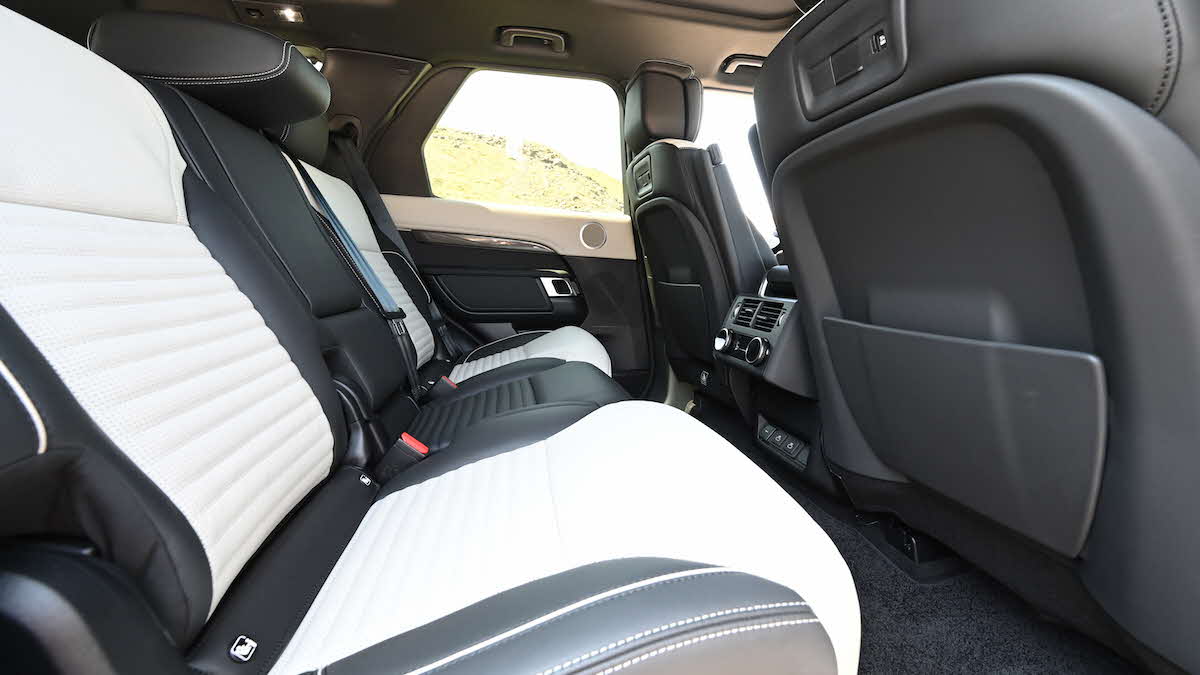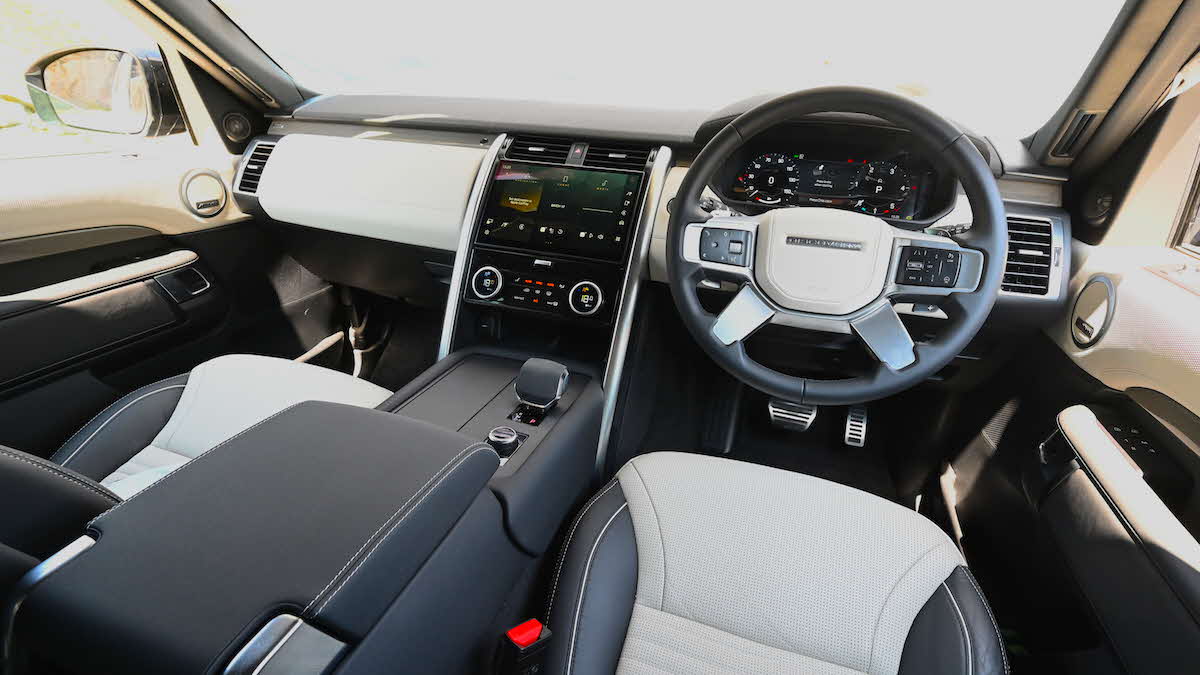Buying a tow car
Read our tips and advice for choosing the right tow car to suit your caravan.
Get helpful adviceJames Batchelor hits the road in an updated caravanning favourite
JLR, the new official name for Jaguar Land Rover, has launched a new ‘house of brands’ approach to its various models, with Jaguar, Range Rover, Defender and Discovery now being seen as separate ‘collections’. Here we take a closer look at the Land Rover Discovery, the traditional, family-orientated SUV so beloved by caravan owners, which was given a significant overhaul in 2021.
 Attractive black-and- white colour scheme
Attractive black-and- white colour schemeThe Discovery has long been a jack-of-all-trades, excelling at everything from coping with rugged terrain to ferrying children on the school-run. The latest model, first introduced in 2017, focused on luxury more than any of its predecessors and pushed this family-friendly SUV further towards Range Rover territory.
Its smoother exterior design, plusher interior and unusually-placed rear number plate irked some critics, not least owners of the boxier previous version, but the model has proven popular – especially with caravanners.
In some ways the current fifth-generation Discovery’s place in the line-up is at odds with the Defender, which has taken many of the old Discovery 4’s strengths and wrapped them up in original Defender design cues to enormous success. JLR says it’ll reinvent the Discovery for its sixth generation and put greater distance between it and the Defender, but until then there’s this overhauled model boasting new features to keep it feeling fresh.
The Discovery now wears updated headlights, a tweaked grille, new rear lights and different front and rear bumpers, while new R-Dynamic and Metropolitan Edition cars have a slightly sportier look. The bulk of the changes are on the inside, as the already-plush Discovery has been bumped even more upmarket with baby Range Rover vibes aplenty. Our top-spec Metropolitan Edition had an attractive pale white and black colour theme with sumptuous ‘Windsor’ leather seats (20-way electrically adjustable, heated and cooling leather versions in the front), but even the entry-level ‘S’ model has a high-class feel.
Along with a newly-designed dashboard and centre console, the biggest change is the addition of JLR’s latest ‘Pivi Pro’ infotainment system. In the Discovery this is accessed via an 11.4in screen and the system itself is a considerable improvement over its predecessors, with crisp graphics, logical menus and fast processing speeds. There are too many features to mention here but the highlights include dedicated off-roading information, fabulous 360˚ cameras, the ability to fold down seats and headrests with a couple of prods of the screen, and the towing menus which allow you to deploy and stow the electric towbar, measure the noseweight and check electrics.
The electric towbar comes as part of a Towing Pack which also includes Land Rover’s signature Terrain Response 2 system, automatic headlight levelling and Tow Assist. The latter is amazingly clever and allows you to control the direction of your caravan while reversing using the rotary dial on the centre console. It's great for fine-tuning tighter manoeuvres.
Space inside remains the same, of course, with plenty of head- and legroom front and back. The Discovery is also a full seven-seater with two seats that rise out of the boot floor (heated in our car); adults can fit in these but they’re more suitable for children and teenagers. Seats fold electrically via buttons located in the boot area or via the car’s touchscreen; fold all of them down and the boot is a cavernous 2,391 litres, although space is predictably confined to a handful of shopping bags with all seven seats in place.
 New dashboard and centre console
New dashboard and centre consoleThe previous Discovery’s range of four-cylinder and V6 engines has been replaced by brand new mild-hybrid straight-six units. There’s a P360 petrol with 355bhp and two diesels – the D250 with 248bhp and the D300 with 297bhp. The petrol is predictably smooth, but so are the diesels, and the petrol is thirsty – JLR claims just 27mpg.
The D250 diesel would be my pick as it offers decent enough performance with 0-62mph taking 7.7sec, and it has plenty of pulling power. Our car was the D300 and this is the one to go for if you need the torque of a diesel and the performance of the petrol, as it whips to 62mph in just 6.5sec. It’s pretty frugal too – during our two-week test I was getting 32mpg and 26mpg when towing. The 3.0-litre straight-six diesel is also amazingly refined, with very little noise or drama. It’s much smoother than the previous Discovery’s V6 diesel engines, and the mild-hybrid assistance gives vibration-free start-ups when the stop/start disengages and helps fill in some dead spots in the diesel’s torque delivery.
All cars get air suspension as standard and on smooth, undulating roads and motorways it just glides along. The Discovery struggles to smooth out pot-holed roads though, especially with this particular car’s 22in wheels, and it does feel very large, which isn’t helped by steering that’s rather slow, making low-speed manoeuvres feel quite cumbersome. It’s easy to place on the road thanks to the lofty elevated driving position.
Of course, there is a host of off-road driving aids with suspension that can rise up, and the car can calibrate the four-wheel drive system for different surfaces. From grass to crawling over rocks, the Discovery can manage it all. Our car was fitted with the optional Active Locking Differential (£1,080) and twin-speed transfer box (£310) for greater off-road ability.
 Smooth exterior design
Smooth exterior designPerhaps the greatest compliment one could level at a towcar is the feeling that you aren’t pulling anything at all. While that sounds a bit pompous, the Discovery really does tow a caravan in its stride. The 3.0-litre diesel barely breaks into a sweat, even on steep hills, and the eight-speed automatic gearbox (the only ’box available) remained smooth and unflustered. The car’s air suspension keeps things nice and level too, and there was no pitching or movement from the caravan even when passing slower moving lorries on motorways. Aside from constricted over-the-shoulder visibility, the Discovery is a fine towcar.
It’s easy to see why the Discovery is loved by caravan owners – it’s just superb at everything it does. The current model is pricey, however, and its sister Defender and Range Rover models offer similar features. But, if you have the money and want a jack-of-all-trades SUV, the Discovery is an excellent choice.